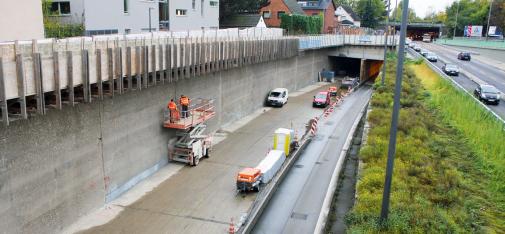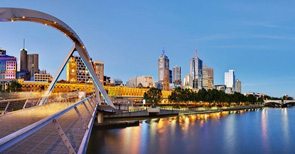-

Rehabilitation of Hamburg’s Wallring Tunnel
MC’s fibre-reinforced concrete replacement product Nafufill KM 250 played a key role in the rehabilitation of Hamburg’s Wallring Tunnel, one of the most important inner-city traffic arteries in the Hanseatic metropolis.
Rehabilitation of Hamburg’s Wallring Tunnel
Hamburg - Germany
The final opening of the two tubes of the Wallring Tunnel to Hamburg’s traffic after four years of extensive modernisation marked the end of a long period of suffering for many motorists. During the successful rehabilitation of this important inner link across the Hanseatic city, the experts from MC's Concrete Repair division were once again able to demonstrate the true extent of their knowledge and experience. MC’s fibre-reinforced concrete replacement product Nafufill KM 250 also played a key role in the renovation project.
The Wallring Tunnel, built between 1963 and 1966 from Glockengiesserwall to Steinstrasse, considerably reduces the above-ground traffic congestion in Hamburg’s city centre near the main railway station. With a daily volume of around 40,000 vehicles, it is now one of the most important inner-city traffic arteries in the Hanseatic metropolis. The tunnel consists of two tubes, each with two carriageways. The central section houses supply facilities, a service gallery and an escape route.
Renewal from scratch
While the structure and its materials were considered state of the art when the Wallring Tunnel opened in 1966, its design falls well short of today's safety and fire protection regulations. But it was not until 2013, when the Hamburg Senate initiated an about-turn in transport policy, that the money was made available for the urgently needed renovation of the ageing structure. The city state’s budget finally allocated to its rehabilitation was 30 million euros. Thus, in 2014, the LSBG (“State Agency for Roads, Bridges and Waterways of the Free and Hanseatic City of Hamburg”) was able to kick off the construction project. The road construction activities began in 2014, with the safety and fire protection work in the two tunnel tubes being initiated in 2016, what the project team to civil engineer Hanns Simons, responsible at LSBG for the “Wallring Tunnel Refurbishment Project” within the organisation’s “Civil Engineering Works”, division quite a bit demanded: “The construction work required had to be carried out while keeping the tunnel tubes operational,” he explains. This meant working a total of 700 nights over the length of the project. In order to keep the traffic flowing as much as possible, it was temporarily routed through the two tunnel tubes on an alternating single-lane basis, with closing times shifted to periods of low traffic density, i.e. nights, weekends and school and public holidays.

© MC-Bauchemie 2025
Hazardous interior cladding
However, the planning engineers had an even bigger headache relating to the safety of the original concrete reinforcement within the tunnel tubes. In order to improve the lighting conditions inside the tunnel, the walls had been covered with frost- and acid-resistant white split-face tiles, creating a cladding of between 3 and 4 cm in thickness on a 1.5 cm layer of mortar. While indeed brightening the interior of the tunnel, this cladding system was far below the standards specified in modern fire protection regulations. In the event of a severe fire in either of the two tunnel tubes, a temperature of more than 500 °C would have occurred at the reinforcement, jeopardising its structural integrity. This potential hazard made it imperative to uprate the entire concrete structure.
Stringent requirements
The fire protection specifications for tunnel construction stipulate that, in the event of a fire, load-bearing reinforcement must not heat up to more than 300 °C. This must be ensured by providing a concrete cover of sufficient thickness. Needless to say, in the case of tunnels in cities with adjacent transport structures, the requirements set are particularly exacting. In line with the engineer's duty of care as specified in the relevant German technical code ZTV-ING, Part 5, and risk analyses based on longer fire durations recently included therein, such tunnels and their reinforcement must be designed so that effective fire resistance is guaranteed for a period of 60 minutes at 1200 °C followed by a 110-minute cooling phase, the purpose being to minimise the probability of failure of the principal structure and also that of any adjacent structures. The construction materials used for such applications must correspond to building material class A (non-combustible) according to DIN 4102 and must not release any substances that could be injurious to either personnel or the structure itself.
Nafufill KM 250 fulfils every requirement
MC’s experts in Product Management and Sales recommended the client LSBG and its planning engineers WvS Zivilingenieure the fire-resistant, fibre-reinforced PCC/SPCC concrete replacement Nafufill KM 250 from MC. Performed by the client’s planning engineers, a comparative test of SPCC concrete replacement systems from various manufacturers for use in the Wallring Tunnel confirmed Nafufill KM 250 as the only SPCC mortar capable of compliance with the criteria implicit in the specified fire curve. This fibre-reinforced concrete replacement is also characterised by its very good flexural and compressive strength behaviour (R 4 mortar to EN 1504 Part 3) and high carbonation resistance.
A mammoth task
Execution of the work was entrusted to the French company EUROVIA, a world leader in road and transport infrastructure construction. Schachtbau Nordhausen Bau GmbH was commissioned with the SPCC work and began installing the Nafufill KM 250 replacement onto the prepared surfaces in November 2016. A layer thickness of approximately 4.5 cm was to be applied by wet spraying. This technique ensures low-dust and low-rebound processing compared to dry-sprayable SPCC mortars, thus also keeping environmental pollution to a minimum. The target area amounted to 21,000 m². The huge volumes involved also meant MC’s logistics would feel the heat: In simple terms, their task was to ensure that a constant flow of Nafufill KM 250 was always available, even though deliveries during the construction phase were limited to the night time. Due to the size of the project and the short construction period, this sometimes meant six 21-tonne truckloads per week. However, the challenge was met in full: During the entire construction phase, there was always enough Nafufill KM 250 available on site for the ongoing spray-coating work. The total quantity ultimately supplied was 2,100 tonnes delivered in 101 truckloads. This constitutes a huge success, achieved through comprehensive advance planning and the friction-free interaction of all participants during the construction phase. This enabled the mammoth project to be completed on schedule and on budget and the Wallringtunnel to be comprehensively renovated and modernised and reopened in July 2018.
-
Name
Rehabilitation of Hamburg’s Wallring Tunnel
-
Country
Hamburg - Germany, 2019
-
Fields of Expertise
-
Categories
-
Products
RELATED CONTENT
-
News
Click here to go to our News section.
-
MC-Pedia
In our MC-Pedia you will find technical articles on various topics written exclusively by our specialists.
-
Magazine
Get our latest issues of our customer and employee magazine MC aktiv.
-
Downloads
Find all relevant datasheets of our products as well as brochures of our company, Fields of Expertise and product categories here.
-
References
Click here to get to our library with reference projects for all types of application.
-
Careers
Click here to go to MC Career.
-
Contact
Click here to go to our Contact section.

